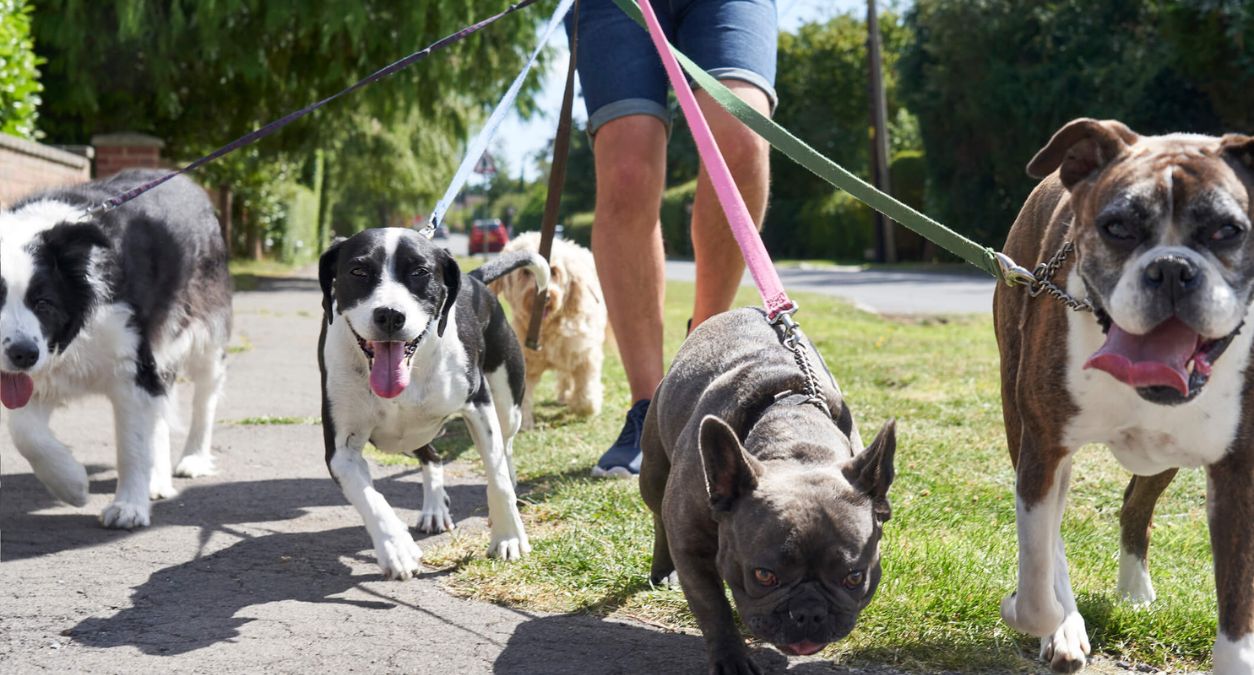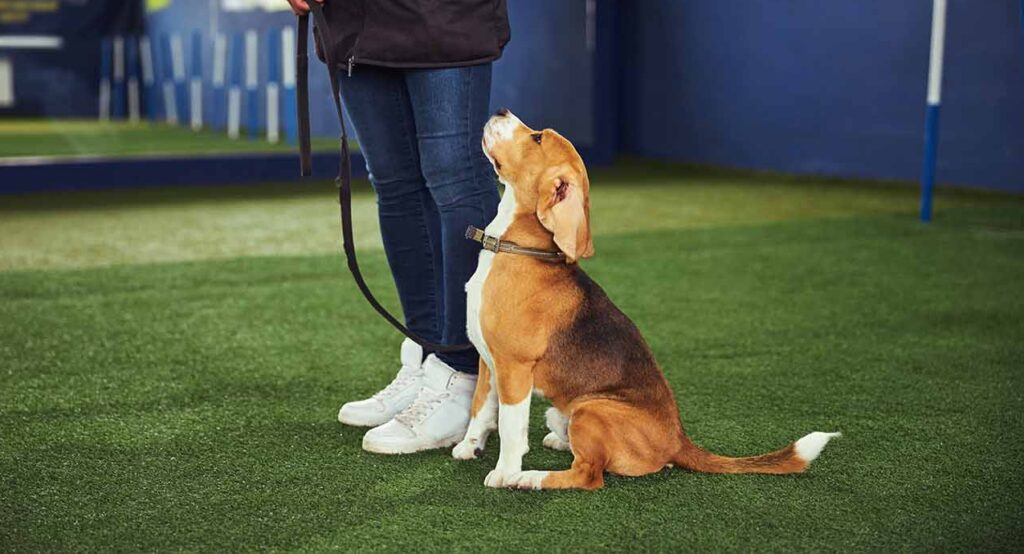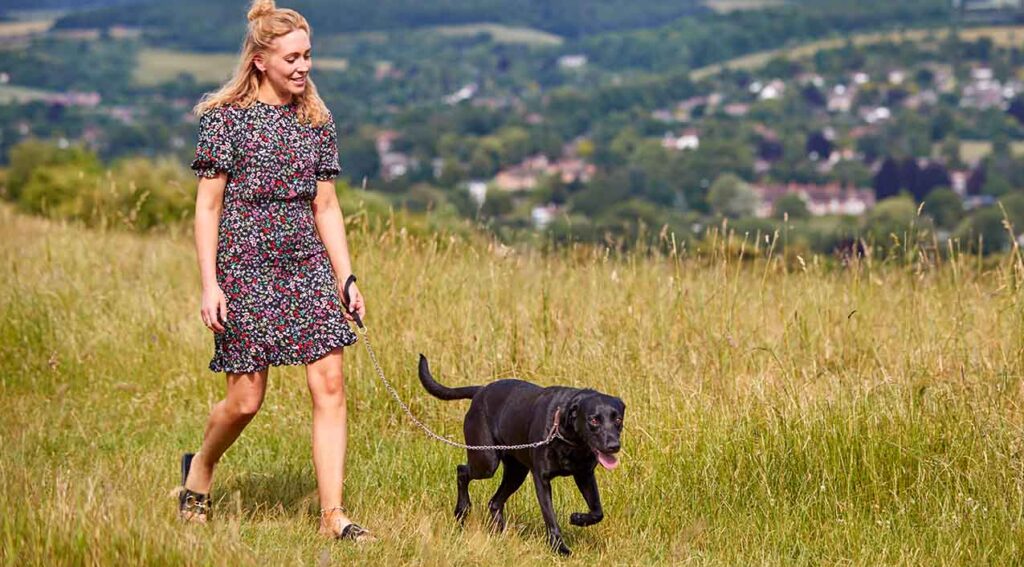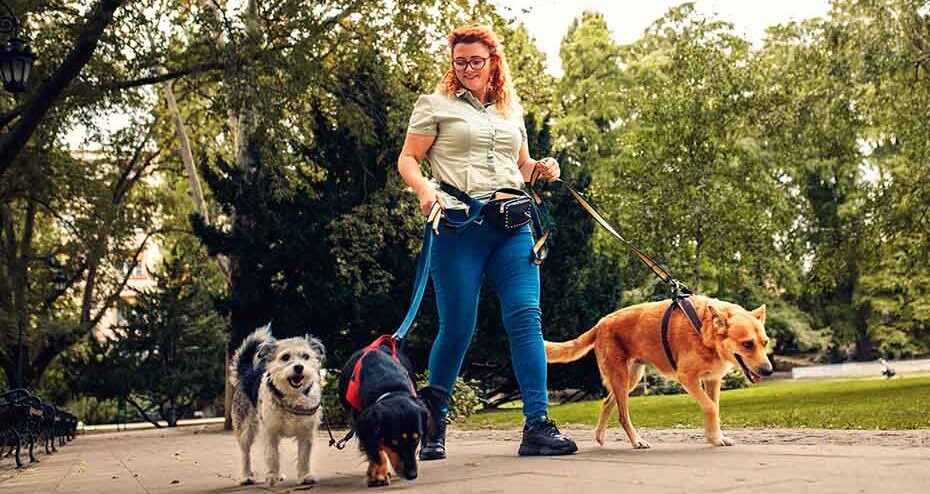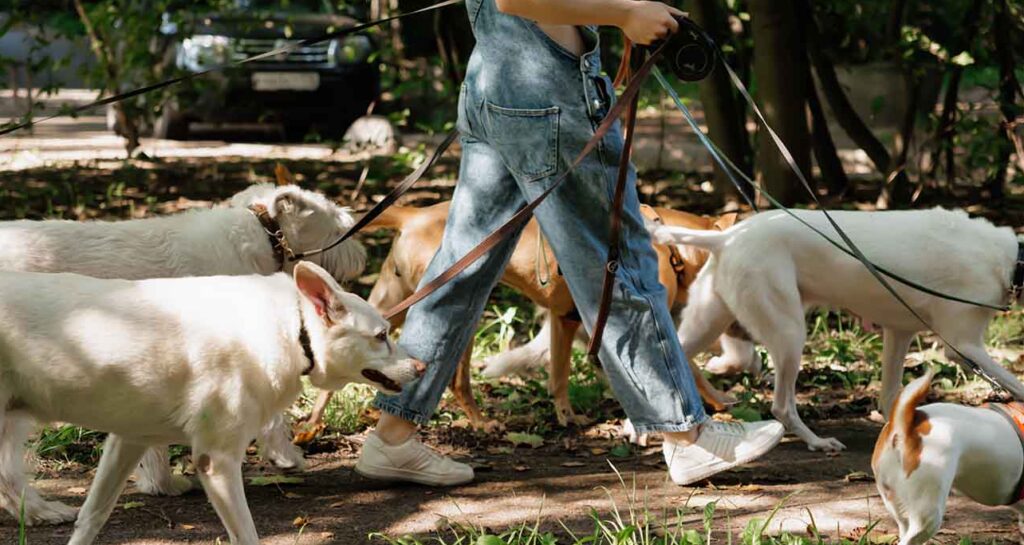Table of contents
Contributors
Steffi joined the business in July 2017 as Business Support Executive. Steffi completed her degree in Sports and ...
How to become a dog walker
Britain is a nation of dog lovers, and everyone wants to make sure that their treasured terrier or cherished cockapoo stays fit and healthy.
The only problem is that with people living such busy lives, because of work, family and other commitments, it can be hard for them to find the time to give their dog proper exercise.
But their challenge could be your opportunity. All over the UK, many people are setting up their own dog walking businesses, taking people’s four-pawed friends out on a stroll for a pre-arranged fee.
It can be great fun and an excellent way to keep yourself fit – but it isn’t quite as simple as knocking on your neighbour’s door and grabbing hold of a lead.
Like any business, there are lots of things that need to be addressed to ensure that a dog walking business runs successfully. In this guide, we’ll take a look at all the steps you need to take to develop a successful dog walking business:
Experience is key!
Dogs can be challenging, especially if they’re not familiar with you, and that’s before considering that the temperament of dogs can vary substantially from one breed to another.
That’s why it’s vital that you have good experience of walking different types of dog (and not just your own if you have one!) before you start.
You’ve also got to be prepared for the weather. If pet owners have enlisted your services to walk their dog, they’ll be expecting you to provide that service even if the weather is bad.
Ensuring you have not only the right equipment and clothing, but also the right mentality for all-weather dog walking, is therefore very important.
Once you’re properly up and running, you should find yourself walking multiple dogs simultaneously. While you may feel confident and experienced enough to handle a large number of dogs, it’s worth considering what your realistic and practical limit would be.
Additionally, you may find that a limitation is placed on you by your insurer (read more about insurance below) – many insurers insist on a maximum of between four and six dogs at any one time.
Dog walking laws and regulations
It might seem like walking a dog is a very simple exercise, but when operating as a walking service, there are lots of rules and regulations that you may have to comply with. These include (but are not necessarily limited to)
Public Space Protection Orders (PSPOs)
PSPOs are put in place by local councils in particular areas to restrict the number of dogs in that space. These are typically local parks or areas where large numbers of dogs may congregate.
Clean Neighbourhoods and Environment Act 2005
Offences such as failing to clear up dog poo properly or not keeping a dog on a lead fall under this legislation, in places where Dog Control Orders apply. Penalties can reach up to a maximum of a £1000 fine.
Control of Dogs Order 1992
All dogs in public places are required by law to wear a collar that includes the name and address of the dog’s owner. This can be written or engraved, but as a dog walker, you should ensure this information is present before you start each walk.
Dangerous Dogs Act 1991
If a dog is considered to be ‘dangerously out of control’, then a criminal offence is being committed by the person deemed to be responsible for its control at the time.
Dogs (Protection of Livestock) Act 1953
If walking dogs around farmland or other rural areas, you should always keep them on leads and well away from any livestock. In the case of farmland, dogs must not chase or attack any kind of livestock; in this scenario, farmers are legally entitled to take measures to protect their animals, potentially up to the point of shooting the dog in question.
The Countryside Code
Although not necessarily legally binding, the UK Government’s Countryside Code provides helpful advice for walking dogs in rural areas responsibly. In particular, it advises to always keep a dog in sight or on a lead, ensure that a dog will return when commanded to do so, and to make sure a dog doesn’t stray into an area where right of way doesn’t apply.
Dog walking qualifications – do you need one?
There is no legal requirement to possess any specific qualifications to run a dog walking business. But getting some dog walking qualifications can be helpful: it can give you additional expertise and experience, and can give you some extra credibility when marketing to potential customers. Potential qualifications to explore include:
Animal care qualifications
Credentials that show an aptitude for taking good care of animals – such as animal behaviour or animal first aid – look good on any CV or website.
City & Guilds
There are a range of City & Guilds Technical Competence Certificates available that relate to dog walking. Of particular relevance are the Level 2 certificates in Dog Walking; Pet Sitting; and Animal Health, Husbandry and Handling; and the Level 3 certificate in Animal Nutrition.
Dog-specific qualifications
A variety of different bodies offer their own courses and certifications aimed at improving the standards of dog walking and animal care, including those at the National Association of Pet Sitters and Dog Walkers, and Think Dog.
Cost and finance considerations
There are plenty of things to take into account on the business side of things when starting out as a dog walker.
Formulating a good business plan should form part of your initial work, helping you establish how you’re going to attract and retain customers, how you can stand out from your competitors, and how you’ll operate day-to-day.
The business plan should also consider any costs you may incur in your operations, in particular around transport.
In bigger cities, it may be possible to use public transport to travel from one client to another (as long as the dog walking market isn’t already saturated).
However, in most cases, your own vehicle will be needed to get yourself around – and your dogs if you want to travel for walks further afield.
You will also need to make a decision about your business status. Initially, it may make more sense to operate as a sole trader, but if your business grows (especially to the point you start to employ other people) it may be beneficial to register as a limited company with Companies House instead.
Dog walking business administration
There are several other business-related duties that you’ll need to fulfil, both as part of the set-up process, and on an ongoing basis once you’re up and running. These include:
Checks
You will need to undergo and pass a criminal record check if you are to enter the houses of any of your customers, or hold their house keys at any point. This means applying to the Disclosure and Barring Service if you’re in England or Wales, Disclosure Scotland, or AccessNI if you’re in Northern Ireland.
Contracts
A solid contract, along with terms and conditions, are vital for clearly defining what you’ll do in return for payment, and to ensure you get paid. It also gives you valuable legal protection in the event of a dispute.
Accounting
Whether you’re a sole trader or limited company, you’ll still be expected to keep and file accounts for tax purposes. You should set up a small business bank account in order to keep business and personal money separate.
Marketing your dog walking business
Getting your dog walking business noticed is one of the most important parts of the job, and it can be one of the trickiest.
There are lots of different ideas you can pursue, but ideally you need to think of ways that stand you out from the crowd, whether that be through different services you offer, attractive pricing, good qualifications (as mentioned above), or through offers, referrals and incentives.
Then you can put these ideas into practice across a range of platforms and mediums. Don’t neglect the more traditional ways of marketing such as leaflets, placing adverts in the local paper or good old word of mouth – these marketing materials may be low-tech but they can still be very effective.
Then of course there’s social media (especially including videos), which should have a clear focus on driving interest towards people making bookings or enquiries, ideally through your website.
A website is essential but it doesn’t have to be overly complex: a few pages explaining who you are, what you do and what stands you out as the best choice gives customers all the information they need to know.
To take your marketing to the next level, consider the ways you can join the dots of all your marketing methods together and build a brand.
In the same way that big businesses have logos, imagery, colour schemes and a tone of voice that makes them instantly recognisable, you can apply many of the same principles on a smaller scale. If you can get these key communication skills right, then your business will be the first one that people think of when they decide to find a dog walker.
Obtain dog walking insurance
Like the qualifications, dog walking insurance is not a legal requirement, but we strongly recommend you take out a policy for a host of reasons.
Firstly, you never know what may happen to you or the dogs that you walk when you’re out and about. Dogs can jump out in front of people, cyclists or cars; they can attack other dogs or cats; their leads can trip up other people (or yourself if you aren’t careful!) – and that’s just three of the things that can happen.
Ensuring that you’re protected if you’re unable to work for whatever reason, and that you can cover any claims arising from injuries or accident damage, including any vet bills incurred.
Exploring public liability insurance and ‘Care, Custody and Control’ cover can ensure that both you and your business are protected, whatever the future may hold.
At Protectivity, we provide a host of dog walking insurance policies so that you can start your new business with confidence. Take a closer look at dog walking business insurance today, and find a wide-ranging policy at a price that suits you.
Get Dog Walking Insurance from Protectivity
*Disclaimer – This blog has been created as general information and should not be taken as advice. Make sure you have the correct level of insurance for your requirements and always review policy documentation. Information is factually accurate at the time of publishing but may have become out of date.
Last updated by




